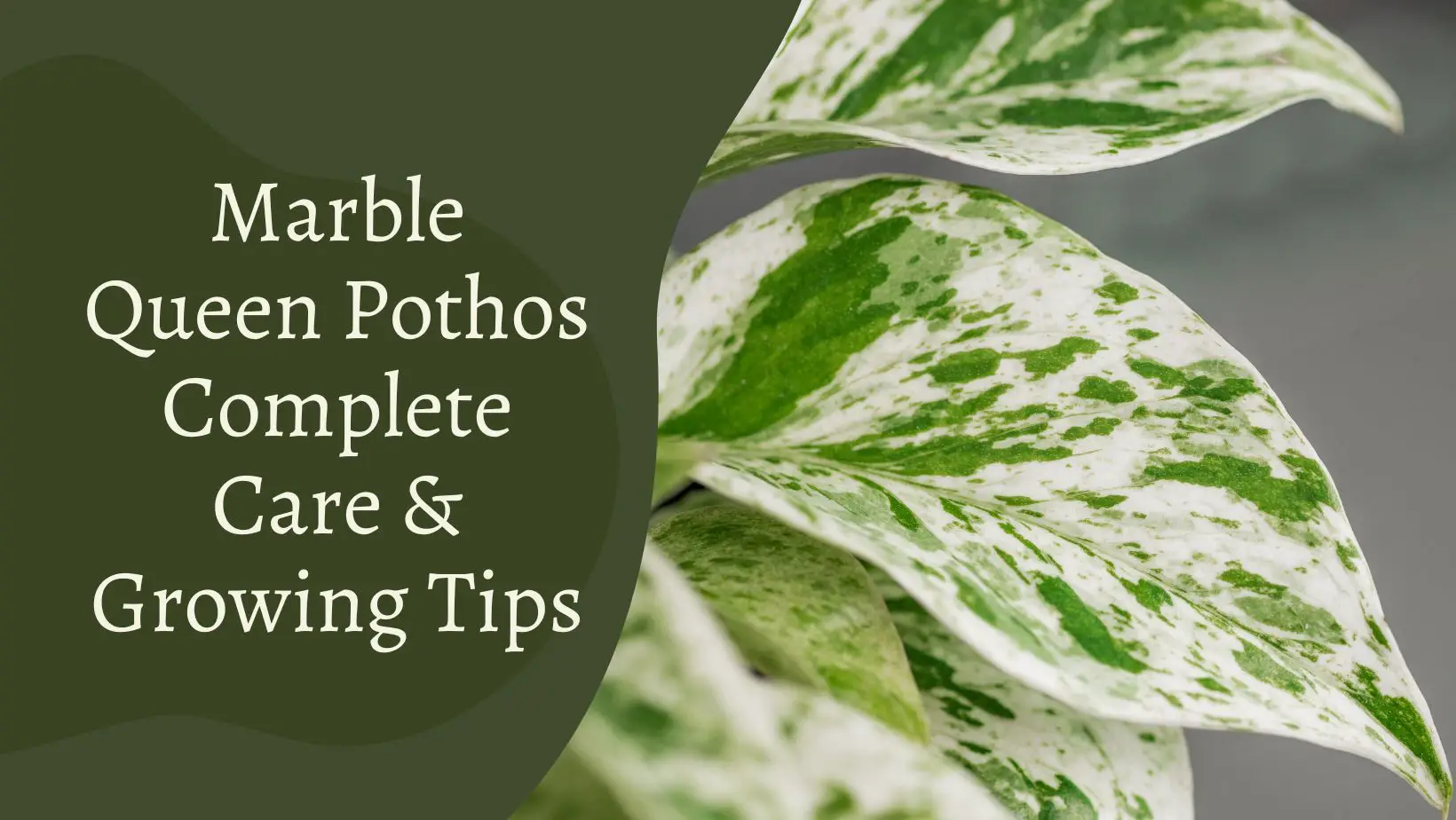
The marble queen pothos (‘Marble Queen’) is a kind of pothos that is distinguished by vining foliage with exquisite white and cream variegation. It is perhaps one of the most popular (and simplest to care for) houseplants available.
The marble queen pothos, like other common types of pothos, grows well indoors and can adapt to a variety of growth environments, making it adaptable and ideal for novices.
Marble queen pothos plants feature exquisite, richly variegated leaves that are jade and cream in color, making them one of the most gorgeous pothos kinds. The climber plant climbs on a moss pole and is ideal for home gardens with indirect lighting.
Unfortunately, if consumed, marble queen pothos is somewhat hazardous to cats, dogs, and people. If you have dogs or little children at home, use cautious with this pothos.

Marble queen plant:
The Marble Queen Pothos is a tropical vine with richly variegated jade and cream leaves that grows in French Polynesia, Southeast Asia, and Australia. Epipremnum aureum is the scientific name for the Marble queen pothos. Because it is difficult to kill, the plant is also known as Devil’s ivy. Pothos is a genus of plants. Araceae is a scientific family of plants.

Soil:
There’s a lot of information on the internet that attempts to make the problem of choosing the best soil mix for Marble Pothos care more complicated. Marble Pothos may be grown in any well-aerated, quick-draining potting soil. If your soil isn’t quick-draining enough, simply add a little sand to the mix and you’ll be OK.
They will grow in nutrient-rich soil, just like any other plant, but they will also thrive in mediocre soil. It’s worth noting that Marble Pothos may be grown in simple water, making it an excellent choice for hydroponic cultivation. It’s extremely typical to discover it growing this way in homes, especially in bathrooms and along the side of kitchen windows.
If you opt to grow Marble Pothos hydroponically, change the water every other week to ensure that your plant receives a new supply of nutrients and that the water does not get murky due to algae build-up (happens as a result of exposure to sunlight).
If you prefer to cultivate your Marble Pothos in water, there are a few things to keep in mind. Carefully trim any roots that look to be decaying before submerging your plant in water. To oxygenate the water and prevent fungal infection, add a drop of hydrogen peroxide.
Once a month, apply liquid fertiliser in a very diluted form (half strength is typically a good starting point). Stick with it once you’ve decided whether you want to cultivate Marble Pothos in soil or water. They have a tendency to become used to one medium and are resistant to change.
Light:
Basic Marble (Light) For newbies, pothos care is a no-brainer because it can thrive in almost any light situation. It does, however, grow quicker in medium to strong indirect light because to its tropical origin. Just keep in mind that growing Marble Pothos in brighter light yields better outcomes with the variegation. The sun burns the leaves, therefore they don’t perform well in direct sunshine.
They are useful as ornamentals in workplaces and low-lit spaces such as bathrooms because to their poor light tolerance. Just keep an eye out for the differences in color.
Only the green sections of the leaves can produce energy for the plant, thus when there isn’t enough light, the leaves will become green to compensate.
Watering:
Watering is the most difficult aspect of caring for Marble Pothos. It’s important to maintain the soil as dry as possible. That makes them tolerant to neglect and uninterested in excessive treatment. I propose using a drench and dry cycle, which means letting the soil mix dry up roughly 50% between waterings. When you water it, make sure it is totally submerged.
This practice of wet and dry watering stimulates plant development, especially during the growing months of spring and summer. In the fall and winter, I let the soil dry up for longer periods of time before watering, relying on misting instead.
Keep an eye out for the leaves. You’re underwatering if you see the margins turning brown and dry. It might be a symptom of overwatering if the leaves turn yellow and the soil feels moist.
Temperature:
Warm temperatures of 65°F to 90°F are ideal for growing Marble Pothos. It may easily survive the winter if kept inside at room temperature.
Humidity
Marble Pothos, like many tropical plants, thrives in a humid climate. Misting should be avoided, according to several online sources on Marble Pothos care. This is where I have to differ.
They enjoy getting misted and it keeps them clean and fresh. If you like, you may even soak the leathery leaves in a sponge bath. When growing Marble Pothos inside in the winter, keep an eye out for brown leaf tips, which indicate air drying.
Fertilizer
Expert gardeners will find that caring for Marble Pothos is unnecessary because this plant does not require fertilisation. You can use any well-balanced general-purpose indoor plant fertiliser.
Organic food is the safest option. From spring until autumn, you can administer once a month. If you want to grow Marble Pothos in water, fertiliser is essential; otherwise, the plant will grow stunted.
The amount of fertiliser you apply will depend on the directions on the fertiliser package as well as the size of your plant and jar.
In any event, just reduce the concentration and frequency by half and you’ll be OK. If you want to go a little more “pro” with your Marble Pothos maintenance, fertilise the soil at least once a month with compost or liquid seaweed solution.
This promotes leaf development and gives the plant a bushier appearance. To be on the safe side, dilute the fertiliser concentration to half the recommended amount. It is preferable to under-fertilize than to over-fertilize. Remember to fertilise only during the growing season and to trim down totally in the winter.
Propagation
These are some of the most straightforward plants to grow. They’re easy to cultivate from stem cuttings and layering. All of the terminals had developed roots and rose erect after a week. That’s all there is to it. Continue reading for a step-by-step guide on propagating and growing Marble Pothos.

marble queen pothos benefits:
The marble queen pothos offers several advantages and benefits.
Among them are the following:
- It’s a low-maintenance plant. They develop without requiring a lot of attention.
- Water or soil are both effective ways to propagate the marble queen plant.
- Low light is not a problem for this plant.
- It can absorb contaminants from the air and is an excellent air cleanser.
- The humidity in the surrounding environment is increased by this plant. Humidity is beneficial to our health since it hydrates our skin and protects us from flu and colds.
- Marble queen pothos is a decorative plant that will enhance the beauty of your space.
- It might make your eyes feel more relaxed.
Marble queen pothos light:
Pothos are tough plants, however highly variegated varieties like Marble Queen require a little more light than greener varieties.The less chlorophyll a plant has, the more intense light it need to support more robust development.
Plants with a lot of variegation grow slower than their greener counterparts, which is why it’s so vital to give your plant the right light. For the finest growth, place your Marble Queen immediately in front of a window.
Marble Queen thrives in windows with no direct sunlight and only brilliant indirect light, but you may discover that a brighter window (such as an Eastern or Western exposure window) with some direct sunlight would help your plant!
Avoid direct sunlight throughout the day, however 2-4 hours of direct sunlight inside is helpful for development. If your house is dark and you don’t get much natural light, you may use a grow lamp to supplement or even grow entirely beneath it.
Marble queen pothos propagation:
Marble queen pothos may be replicated simply from stem cuttings, which is a terrific method to stimulate fuller development on your existing plant or to make new plants to share with friends. Follow these methods to propagate your marble queen pothos:
Marble Queen Pothos cuttings can be used to propagate the plant (in soil)
- Select a robust, healthy vine from the Marble Pothos mother plant, taking note of the vine’s soil end.
- Using a pair of sharp garden scissors, cut the stem into four nodes and a terminal.
- Ideally, pick a thick, sturdy vine that hasn’t grown too long so that you may cut near to the earth. The nodes that are close to the earth take root consistently. If you can see aerial roots on the nodes of the Marble Pothos cutting at the soil end, that’s even better.
- Pinch the lower leaves to reveal the nodes, leaving just the terminal leaves.
- Use the mother plant’s container. The soil must be loosened to a depth of at least 5 inches.
- If you’re using a new pot, I recommend selecting a medium-sized pot and grouping numerous cuttings together, such as three to five. The outcome will be a bushy pot. A word of advice: don’t space the cuttings too far apart. Plant them in a single clump in the centre of the container.
- Because Marble Pothos cuttings are prone to decaying before roots, the soil must be well-draining.
- Marble Pothos cuttings do not require a rooting hormone because they usually root quickly.
- Insert the stem(s) into the soil with at least one node deep below the surface and push the dirt down for support.
- Place the pot in a sunny but shady location away from direct sunlight.
- Keep the soil wet and watered until the cutting is established. This should take between one and two weeks.
- When the terminal leaves perk up, you’ll know they’re ready.
Marble Queen Pothos should be propagated in water.
- Follow the instructions in the preceding section up to step 4.
- Choose a jar with an opening at least 3 inches wide and a depth only deep enough to submerge the bottom two nodes of the cutting but not the terminal leaves. Jars that are taller work nicely.
- Pro tip: When removing the cutting out of the jar, if the opening is too narrow, the roots will break.
- Place your cutting in a clean water-filled container.
- If the cutting isn’t sitting nicely in the jar, I cover the opening with cling foil, allowing just enough space for the cutting to pass through. This should assist in keeping the cutting in place.
- Place the jar in a location that receives indirect sunlight and don’t move it too often.
- After 1–2 weeks, new roots will develop from the submerged nodes.
- Once the roots are an inch or two long, you may either transplant the cutting to soil or let it develop in water.
- Choose an excellent grade balanced liquid fertiliser to feed your Marble Pothos if you wish to grow it in water. Once a month, fertilise your plant.

Marble queen pothos humidity:
When the humidity levels are between 40 and 60 percent, the Marble queen pothos thrives. The plant benefits from average indoor humidity. Humidity is also crucial since it influences how your plant collects moisture and nutrients from the soil over time.
Use a pebble tray filled with water or a humidifier to improve the humidity around your Marble Queen pothos. Some gardeners go so far as to sprinkle the leaves to increase the humidity. If you opt to walk this path, start early in the afternoon to avoid damp leaves as the temperature begins to fall.
Use the following ways to maintain optimal humidity levels:
- Spray the leaves with water.
- Placing the plant on a pebble tray is a good idea.
- Wipe the leaves clean.
- Make use of a humidifier.
- In the bathroom or kitchen, place the plant.
How big do marble queen pothos get:
When properly cared for, Marble Queen Pothos grow exceptionally quickly indoors. A Marble Queen plant’s vines may grow up to 6 to 10 feet in length. It’s critical to supply your plant with the proper lighting, feeding, and watering to support rapid development.

Snow queen pothos:
Snow queen pothos and marble queen pothos are extremely similar. The leaves of both plants have the same form, but they are different hues. The Epipremnum aureum, more popularly known as pothos, has a unique variety called Snow Queen Pothos.
The snow queen pothos, on the other hand, is distinct from the conventional lime green golden pothos in more ways than one. This pothos type is a little more particular about how it wants its habitat and care to be. While this may make keeping the plant happy and healthy more difficult, it’s still a pothos, so it’s unlikely to die on you while you’re getting to know your new white-green companion.
It’s also much simpler to figure out what problems your snow queen pothos plant is having based on how it appears, and it’ll respond rapidly once those problems are resolved. Pothos including the snow queen type, are cultivars, which implies they’re a man-made variation of the original plant.
Cultivars are created by selective breeding to increase the amount of a specific feature. Color, insect resistance, and how much light a plant requires to survive are all examples of these qualities. In addition, most cultivars are designed to produce a certain type of variegation. The variegation of the appropriately titled snow queen is possibly the most captivating of all the pothos varieties available.
Snow queen vs marble queen pothos:
- Snow Queen Pothos and Marble Queen Pothos are distinguished primarily by their leaf coloring and growth characteristics.
- The foliage of Snow Queen Pothos is more white, and it grows more slowly.
- Marble Queen Pothos, on the other hand, is cream-colored with more green spots. It expands at a faster rate.
- The variations between the snow queen and marble queen pothos aren’t only cosmetic; they differ in length and development pace as well.
- The quantity of white on the foliage of the snow and marble queen pothos is the most visible difference.
- As previously said, the snow queen is mostly white with mild green undertones. A snow queen’s white tones are a brighter, more clear white.
- The marble queen pothos, on the other hand, has a darker green colour and a dimmer white colour. More crucially, the distribution of green and white is more even, resulting in a less dazzling overall appearance of the plant.
- Because it has more chlorophyll, the marble queen is supposed to grow quicker than the snow queen pothos, although it really grows somewhat slower.
- This is most likely due to the fact that a marble queen’s development is focused on new leaves rather than longer stems. In addition, the marble queen pothos trails less and grows bushier than the snow queen.
- In other words, each plant’s colour pattern is inverted. The Snow Queen Pothos plant has more white than green regions, whereas the Marble Queen Pothos plant has more green areas.
Golden vs marble queen pothos:
The colour and design of the leaves are the key differences between Marble Queen Pothos and Golden Pothos. The marks on Marble Queen Pothos are significantly finer and lighter in colour than those on Golden Pothos.
Color and Variegation of the Foliage
The colour of the leaf is the most noticeable distinction between Golden Pothos and Marble Queen Pothos. The leaves of the Golden Pothos are medium to dark green with golden splashes. The yellow spots on the leaves can be huge or little, and some leaves have more than others.
The leaves of the Marble Queen Pothos are creamy white or light green in colour, with a lovely pattern of yellow and deeper greens. These patches are usually tiny and numerous, creating a marbled look on the leaves.
Plant Size and Growth Habit
Pothos plants are all vines, which means they have a long, trailing habit that is ideal for hanging baskets and fascinating, cascading arrangements. You may even teach your Pothos to grow plants on shelving or curtain poles in your house.
Due to the absence of chlorophyll in its pale leaves, Marble Queen Pothos develops slowly.
In the correct conditions, Golden Pothos may grow up to a foot every month!
Taxonomy:
Taxonomy Golden Pothos is also known as devil’s ivy, money plant, and Ceylon creeper in different parts of the world. Pothos’ extraordinary durability — it is nearly hard to kill – is referenced in several of these names.
Golden Pothos gets its name from the gorgeous hue of its leaves, which are variegated green and golden and look as if they’ve been sprayed with gold. Marble Queen Pothos gets its name from the exquisite variegation of its leaves, which seem marbled.
Requirements for light
Marble Queen Pothos need a brighter atmosphere than Golden Pothos to survive because to its highly variegated leaves, which contain relatively little chlorophyll (the material that gives plants their green colour and helps them to photosynthesize).
The Golden Pothos is one of the few plants that can grow in fluorescent light. As a result, it’s highly popular in enclosed spaces like workplaces and retail malls. To photosynthesize, Marble Queen Pothos need a lot of bright, indirect light. Golden Pothos is tolerant to all lighting conditions.
Conclusion:
The most magnificent and luscious climbing stems are formed by marble queen pothos plants. Marble queen pothos plants are easy to care for and have a long lifespan. The Marble Queen Pothos requires bright, indirect light to thrive. When water is supplied to the plant with care, it grows better. Overwatering and underwatering are both hazardous to the plant.
Use a potting mix that drains effectively. Maintain the plant’s correct humidity levels. During the summer and spring, fertilise your lawn twice a month. During the growth season, repot your Marble queen pothos every 2 to 3 years.
To give your plant a better appearance, prune it. Remove any dead, discoloured, or damaged leaves from the long stems. The Marble Queen Pothos is easy to propagate. Propagation may be done in a variety of ways, including by soil or water.
Pets and children are both poisoned by the plant. Pests such as mealybugs, spider mites, fungal grants, and scales damage the plant on occasion. The plant acts as a natural air filter. The marble queen pothos is, in a nutshell, a classic houseplant. For a great growing experience, follow the growing and troubleshooting tips above.

Hi This is Maria, We are a team of gardening enthusiasts with a passion for gardening. We have tried to bring you tips and advice enabling you to grow and maintain a healthy and beautiful garden. We Hope You Find it Useful.






